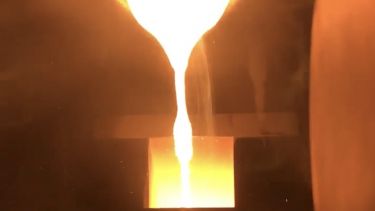Utilising the Henry Royce Institute expertise and equipment, this on-going project oversaw two alloys' manufacturing processes to evaluate the effect of Chromium [Cr] on precipitation, ferrite fraction, and morphology.
To evaluate the effect on the tensile properties, the components were reheated and isothermally transformed, whilst the reheating temperature was altered.
CONTEXT
Recently, a new family of steels have been introduced, based on a ferritic microstructure with a fine-grain size, strengthened through extensive interphase precipitation.
These have the potential to attain the 1.2 GPa, using existing commercial production lines, however, further research is required to meet this target.
In response to these current challenges, the project aims to achieve a tensile strength of 1.2GPa, with a ductility of at least 15%.
RESULTS
The project aims to understand how ternary micro alloy additions affect the microstructure and properties of the alloys.
The primary issue to address related to the effect of small Cr additions, which have brought confusing results in the past. Some researchers have suggested that Cr was beneficial whereas others have maintained it was detrimental.
Based on the composition 0.1%C-1.5%Mn-0.2%Si-0.2%V-0.5%Mo from a patented alloy of Tata Steel, two blocks of steel were manufactured.
Dr. Yunus Azakli assisted in the process, using the Consarc 10 kg VIM furnace, which is now located in the Royce Discovery Centre.
The results of this study have not yet be published, due to a COVID-19 related delay in the provided STEM training.
STEM analysis would provide crucial information related to the nanoprecipitates within the alloy such as: shape, volume fraction, diameter, inter-particle spacing, and the elemental composition.
FUTURE IMPACT
This project aims to produce a larger quantity of steels with very similar compositions in the near future, to further investigate their properties.
These steels will be heat-treated at different temperatures, with the aim of maximising the ferrite volume fraction, and the precipitate formation during the γ→α transformation. Should superior mechanical properties be obtained, those steels will likely be implemented within the automotive industry.
This project could be the driver for the next generation of low-cost steels for the automotive industry. If the upcoming mechanical test results surpass the mechanical properties that the automotive industry demands, the steels can directly be implemented in the industry.
It will also pave the way for the production and characterisation of new alloys that the researcher would propose once the characterisation and the tendency is attained.
Karol Felipe Rodgriguez
PhD Student | Department of Materials Science and Engineering | The University of Sheffield
COLLABORATORS
Dr. Yunus Azakli, Neil Hind, Dean Haylock, and Dr. Lisa Hollands



